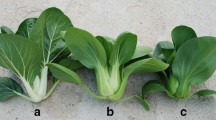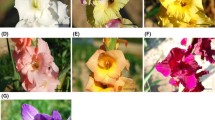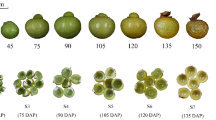Abstract
Plant metabolites are important for plant development and human health. Plants of celery (Apium graveolens L.) with different-colored petioles have been formed in the course of long-term evolution. However, the composition, content distribution, and mechanisms of accumulation of metabolites in different-colored petioles remain elusive. Using ultra-high performance liquid chromatography-tandem mass spectrometry (UHPLC-MS/MS), 1159 metabolites, including 100 lipids, 72 organic acids and derivatives, 83 phenylpropanoids and polyketides, and several alkaloids and terpenoids, were quantified in four celery cultivars, each with a different petiole color. There were significant differences in the types and contents of metabolites in celery with different-colored petioles, with the most striking difference between green celery and purple celery, followed by white celery and green celery. Annotated analysis of metabolic pathways showed that the metabolites of the different-colored petioles were significantly enriched in biosynthetic pathways such as anthocyanin, flavonoid, and chlorophyll pathways, suggesting that these metabolic pathways may play a key role in determining petiole color in celery. The content of chlorophyll in green celery was significantly higher than that in other celery cultivars, yellow celery was rich in carotenoids, and the content of anthocyanin in purple celery was significantly higher than that in the other celery cultivars. The color of the celery petioles was significantly correlated with the content of related metabolites. Among the four celery cultivars, the metabolites of the anthocyanin biosynthesis pathway were enriched in purple celery. The results of quantitative real-time polymerase chain reaction (qRT-PCR) suggested that the differential expression of the chalcone synthase (CHS) gene in the anthocyanin biosynthesis pathway might affect the biosynthesis of anthocyanin in celery. In addition, HPLC analysis revealed that cyanidin is the main pigment in purple celery. This study explored the differences in the types and contents of metabolites in celery cultivars with different-colored petioles and identified key substances for color formation. The results provide a theoretical basis and technical support for genetic improvement of celery petiole color.
摘要
目的
对四种不同颜色芹菜的呈色物质进行比较分析, 探讨芹菜叶柄颜色形成的机理。
创新点
明确了芹菜叶柄颜色形成的主要差异代谢物的调控途径。
方法
以四个叶柄颜色差异明显的芹菜品种(白色、黄色、绿色和紫色)为材料, 利用非靶代谢组学分析, 探讨了叶柄的代谢物成分, 对四个品种的花青素、叶绿素、类胡萝卜素含量进行测定, 研究不同品种富含的代谢物进而探讨不同颜色形成的机理, 进一步运用高效液相色谱技术(HPLC)进行代谢物验证, 并结合基因表达揭示了芹菜叶柄颜色呈色的差异代谢物调控途径。
结论
不同颜色芹菜叶柄中叶绿素、花青素、类胡萝卜素含量差异显著, 花青素和叶绿素分别在紫色和绿色品种中大量积累, 表明花青素与叶绿素可能在芹菜叶柄颜色中起关键作用。利用非靶代谢组学在四个品种中检测到647种差异代谢物, 不同颜色芹菜代谢物质种类和含量存在显著差异, 绿色芹菜富含与叶绿素生物合成途径相关的代谢物, 紫色芹菜富含与花青素生物合成途径的代谢物。进一步采用HPLC验证显示矢车菊素是紫芹的主要色素。为探究代谢物和基因表达的相关性, 采用实时定量聚合酶链反应(qRT-PCR)进行表达量分析, 结果与代谢物积累趋势一致。此外, 不同颜色的芹菜富含不同的营养物质, 例如, 具有生物活性的代谢物如芹菜素和儿茶素被发现在绿芹中显著富集。本研究鉴定出丰富的代谢产物不仅为研究芹菜的生物活性物质提供了信息, 也为挖掘不同颜色植物的代谢产物提供参考。
Similar content being viewed by others
References
Beale SI, 2005. Green genes gleaned. Trends Plant Sci, 10(7): 309–312. https://doi.org/10.1016/j.tplants.2005.05.005
Chen C, Zhou G, Chen J, et al., 2021. Integrated metabolome and transcriptome analysis unveils novel pathway involved in the formation of yellow peel in cucumber. Int J Mol Sci, 22(3):1494. https://doi.org/10.3390/ijms22031494
Cotter D, Maer A, Guda C, et al., 2006. LMPD: LIPID MAPS proteome database. Nucleic Acids Res, 34(S1): D507–D510. https://doi.org/10.1093/nar/gkj122
Dong T, Han RP, Yu JW, et al., 2019. Anthocyanins accumulation and molecular analysis of correlated genes by metabolome and transcriptome in green and purple asparaguses (Asparagus officinalis, L.). Food Chem, 271:18–28. https://doi.org/10.1016/j.foodchem.2018.07.120
Eckhardt U, Grimm B, Hörtensteiner S, 2004. Recent advances in chlorophyll biosynthesis and breakdown in higher plants. Plant Mol Biol, 56(1):1–14. https://doi.org/10.1007/s11103-004-2331-3
Feng K, Liu JX, Xing GM, et al., 2019. Selection of appropriate reference genes for RT-qPCR analysis under abiotic stress and hormone treatment in celery. PeerJ, 7: e7925. https://doi.org/10.7717/peerj.7925
Fenger JA, Roux H, Robbins RJ, et al., 2021. The influence of phenolic acyl groups on the color of purple sweet potato anthocyanins and their metal complexes. Dyes Pigments, 185:108792. https://doi.org/10.1016/J.DYEPIG.2020.108792
Ferreyra MLF, Rius SP, Casati P, 2012. Flavonoids: biosynthesis, biological functions, and biotechnological applications. Front Plant Sci, 3:222. https://doi.org/10.3389/fpls.2012.00222
Fiehn O, 2002. Metabolomics—the link between genotypes and phenotypes. Plant Mol Biol, 48(1–2):155–171. https://doi.org/10.1023/A:1013713905833
Grotewold E, 2006. The genetics and biochemistry of floral pigments. Annu Rev Plant Biol, 57:761–780. https://doi.org/10.1146/annurev.arplant.57.032905.105248
Han XY, Luo YT, Lin JY, et al., 2021. Generation of purple-violet chrysanthemums via anthocyanin B-ring hydroxylation and glucosylation introduced from Osteospermum hybrid F3′5′H and Clitoria ternatea A3′5′GT. Ornament Plant Res, 1:4. https://doi.org/10.48130/OPR-2021-0004
Jan R, Asaf S, Paudel S, et al., 2021. Discovery and validation of a novel step catalyzed by OsF3H in the flavonoid biosynthesis pathway. Biology, 10(1):32. https://doi.org/10.3390/biology10010032
Jewett MC, Hofmann G, Nielsen J, 2006. Fungal metabolite analysis in genomics and phenomics. Curr Opin Biotechnol, 17(2):191–197. https://doi.org/10.1016/j.copbio.2006.02.001
Jia LD, Wang JS, Wang R, et al., 2021. Comparative transcriptomic and metabolomic analyses of carotenoid biosynthesis reveal the basis of white petal color in Brassica napus. Planta, 253:8. https://doi.org/10.1007/s00425-020-03536-6
Jiang SK, Zhang XJ, Xu ZJ, et al., 2010. Comparison between QTLs for chlorophyll content and genes controlling chlorophyll biosynthesis and degradation in Japonica rice. Acta Agronom Sin, 36(3):376–384. https://doi.org/10.1016/S1875-2780(09)60036-5
Li MY, Hou XL, Wang F, et al., 2018. Advances in the research of celery, an important Apiaceae vegetable crop. Crit Rev Biotechnol, 38(2):172–183. https://doi.org/10.1080/07388551.2017.1312275
Li SP, Deng BL, Tian S, et al., 2021. Metabolic and transcriptomic analyses reveal different metabolite biosynthesis profiles between leaf buds and mature leaves in Ziziphus jujuba Mill. Food Chem, 347:129005. https://doi.org/10.1016/j.foodchem.2021.129005
Li XB, Wang Y, Jin L, et al., 2021. Development of fruit color in Rubus chingii Hu (Chinese raspberry): a story about novel offshoots of anthocyanin and carotenoid biosynthesis. Plant Sci, 311:110996. https://doi.org/10.1016/j.plantsci.2021.110996
Liu HN, Su J, Zhu YF, et al., 2019. The involvement of PybZIPa in light-induced anthocyanin accumulation via the activation of PyUFGT through binding to tandem G-boxes in its promoter. Hortic Res, 6:134. https://doi.org/10.1038/s41438-019-0217-4
Liu Y, Tikunov Y, Schouten RE, et al., 2018. Anthocyanin biosynthesis and degradation mechanisms in Solanaceous vegetables: a review. Front Chem, 6:52. https://doi.org/10.3389/fchem.2018.00052
Liu Y, Shao YR, Li XY, et al., 2020. Analysis of nicotine-induced metabolic changes in Blakeslea trispora by GC-MS. J Zhejiang Univ-Sci B (Biomed & Biotechnol), 21(2): 172–177. https://doi.org/10.1631/jzus.B1900459
Ma Y, Feng YH, Diao TW, et al., 2020. Experimental and theoretical study on antioxidant activity of the four anthocyanins. J Mol Struct, 1204:27509. https://doi.org/10.1016/j.molstruc.2019.127509
Masoudi-Nejad A, Goto S, Jauregui R, et al., 2007. EGENES: transcriptome-based plant database of genes with metabolic pathway information and expressed sequence tag indices in KEGG. Plant Physiol, 144(2):857–866. https://doi.org/10.1104/pp.106.095059
Nagella P, Ahmad A, Kim SJ, et al., 2012. Chemical composition, antioxidant activity and larvicidal effects of essential oil from leaves of Apium graveolens. Immunopharm Immunot, 34(2):205–209. https://doi.org/10.3109/08923973.2011.592534
Nakabayashi R, Yonekura-Sakakibara K, Urano K, et al., 2014. Enhancement of oxidative and drought tolerance in Arabidopsis by overaccumulation of antioxidant flavonoids. Plant J, 77(3):367–379. https://doi.org/10.1111/tpj.12388
Oliver MJ, Guo LN, Alexander DC, et al., 2011. A sister group contrast using untargeted global metabolomic analysis delineates the biochemical regulation underlying desiccation tolerance in Sporobolus stapfianus. Plant Cell, 23(4):1231–1248. https://doi.org/10.1105/tpc.110.082800
Patil RH, Babu RL, Naveen KM, et al., 2015. Apigenin inhibits PMA-induced expression of pro-inflammatory cytokines and AP-1 factors in A549 cells. Mol Cell Biochem, 403(1–2):95–106. https://doi.org/10.1007/s11010-015-2340-3
Peng YY, Lin-Wang K, Cooney JM, et al., 2019. Differential regulation of the anthocyanin profile in purple kiwifruit (Actinidia species). Hortic Res, 6:3. https://doi.org/10.1038/s41438-018-0076-4
Pfaffl MW, 2001. A new mathematical model for relative quantification in real-time RT-PCR. Nucleic Acids Res, 29(9):e45. https://doi.org/10.1093/nar/29.9.e45
Shi QQ, Du JT, Zhu DJ, et al., 2020. Metabolomic and transcriptomic analyses of anthocyanin biosynthesis mechanisms in the color mutant Ziziphus jujuba cv. Tailihong. J Agric Food Chem, 68(51):15186–15198. https://doi.org/10.1021/acs.jafc.0c05334
Song XM, Sun PC, Yuan JQ, et al., 2021. The celery genome sequence reveals sequential paleo-polyploidizations, karyotype evolution and resistance gene reduction in apiales. Plant Biotechnol J, 19(4):731–744. https://doi.org/10.1111/pbi.13499
Sowbhagya HB, 2014. Chemistry, technology, and nutraceutical functions of celery (Apium graveolens L.): an overview. Crit Rev Food Sci Nutr, 54(3):389–398. https://doi.org/10.1080/10408398.2011.586740
Sun TH, Yuan H, Cao HB, et al., 2018. Carotenoid metabolism in plants: the role of plastids. Mol Plant, 11(1):58–74. https://doi.org/10.1016/j.molp.2017.09.010
Tan GF, Ma J, Zhang XY, et al., 2017. AgFNS overexpression increase apigenin and decrease anthocyanins in petioles of transgenic celery. Plant Sci, 263:31–38. https://doi.org/10.1016/j.plantsci.2017.07.001
Wang LY, Tian YC, Shi W, et al., 2020. The miR396-GRFs module mediates the prevention of photo-oxidative damage by brassinosteroids during seedling de-etiolation in Arabidopsis. Plant Cell, 32(8):2525–2542. https://doi.org/10.1105/tpc.20.00057
Wang M, Chen L, Liang ZJ, et al., 2020. Metabolome and transcriptome analyses reveal chlorophyll and anthocyanin metabolism pathway associated with cucumber fruit skin color. BMC Plant Biol, 20:386. https://doi.org/10.1186/s12870-020-02597-9
Want EJ, Masson P, Michopoulos F, et al., 2013. Global metabolic profiling of animal and human tissues via UPLC-MS. Nat Protoc, 8(1):17–32. https://doi.org/10.1038/nprot.2012.135
Wei K, Zhang YZ, Wu LY, et al., 2016. Gene expression analysis of bud and leaf color in tea. Plant Physiol Biochem, 107: 310–318. https://doi.org/10.1016/j.plaphy.2016.06.022
Wen B, Mei ZL, Zeng CW, et al., 2017. metaX: a flexible and comprehensive software for processing metabolomics data. BMC Bioinformatics, 18:183. https://doi.org/10.1186/s12859-017-1579-y
Wishart DS, Tzur D, Knox C, et al., 2007. HMDB: the human metabolome database. Nucleic Acids Res, 35(S1): D521–D526. https://doi.org/10.1093/nar/gkl923
Wu YQ, Guo J, Wang TL, et al., 2020. Metabolomic and transcriptomic analyses of mutant yellow leaves provide insights into pigment synthesis and metabolism in Ginkgo biloba. BMC Genomics, 21:858. https://doi.org/10.1186/s12864-020-07259-6
Xia Y, Chen WW, Xiang WB, et al., 2021. Integrated metabolic profiling and transcriptome analysis of pigment accumulation in Lonicera japonica flower petals during colour-transition. BMC Plant Biol, 21:98. https://doi.org/10.1186/s12870-021-02877-y
Xu ZS, Yang QQ, Feng K, et al., 2020. DcMYB113, a root-specific R2R3-MYB, conditions anthocyanin biosynthesis and modification in carrot. Plant Biotechnol J, 18(7): 1585–1597. https://doi.org/10.1111/pbi.13325
Zeng ZQ, Lin TZ, Zhao JY, et al., 2020. OsHemA gene, encoding glutamyl-tRNA reductase (GluTR) is essential for chlorophyll biosynthesis in rice (Oryza sativa). J Integr Agr, 19(3):612–623. https://doi.org/10.1016/S2095-3119(19)62710-3
Zhang LY, Yu YB, Yu RZ, 2020. Analysis of metabolites and metabolic pathways in three maize (Zea mays L.) varieties from the same origin using GC-MS. Sci Rep, 10:17990. https://doi.org/10.1038/s41598-020-73041-z
Zhang WJ, Liu C, Yang RJ, et al., 2019. Comparison of volatile profiles and bioactive components of sun-dried Pu-erh tea leaves from ancient tea plants on Bulang Mountain measured by GC-MS and HPLC. J Zhejiang Univ-Sci B (Biomed & Biotechnol), 20(7):563–575. https://doi.org/10.1631/jzus.B1800183
Zhou DD, Li R, Zhang H, et al., 2020. Hot air and UV-C treatments promote anthocyanin accumulation in peach fruit through their regulations of sugars and organic acids. Food Chem, 309:125726. https://doi.org/10.1016/j.foodchem.2019.125726
Zhu T, Wang X, Xu ZM, et al., 2020. Screening of key genes responsible for Pennisetum setaceum ‘Rubrum’ leaf color using transcriptome sequencing. PLoS ONE, 15(11): e0242618. https://doi.org/10.1371/journal.pone.0242618
Acknowledgments
This work was supported by the National Natural Science Foundation of China (No. 32002027).
Author information
Authors and Affiliations
Corresponding author
Additional information
Author contributions
Conceptualization: Mengyao LI and Haoru TANG; Data curation: Jie LI, Ya LUO, Yong ZHANG, and Yan WANG; Formal analysis: Haohan TAN and Yunting ZHANG; Investigation: Yuanxiu LIN, Qing CHEN, and Haohan TAN; Writing-original draft: Mengyao LI and Jie LI; Writing-editing: Xiaorong WANG. All authors have read and approved the final manuscript, and therefore, have full access to all the data in the study and take responsibility for the integrity and security of the data.
Compliance with ethics guidelines
Mengyao LI, Jie LI, Haohan TAN, Ya LUO, Yong ZHANG, Qing CHEN, Yan WANG, Yuanxiu LIN, Yunting ZHANG, Xiaorong WANG, and Haoru TANG declare that they have no conflict of interest.
This article does not contain any studies with human or animal subjects performed by any of the authors.
Supplementary information
Tables S1–S5; Figs. S1 and S2
Rights and permissions
About this article
Cite this article
Li, M., Li, J., Tan, H. et al. Comparative metabolomics provides novel insights into the basis of petiole color differences in celery (Apium graveolens L.). J. Zhejiang Univ. Sci. B 23, 300–314 (2022). https://doi.org/10.1631/jzus.B2100806
Received:
Accepted:
Published:
Issue Date:
DOI: https://doi.org/10.1631/jzus.B2100806




